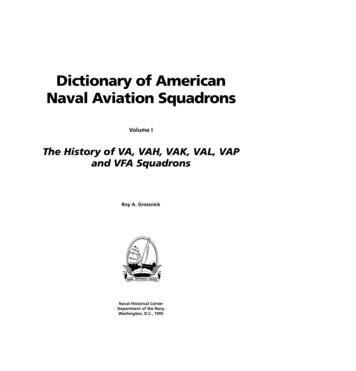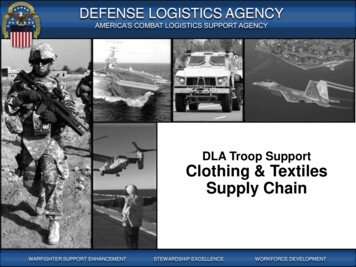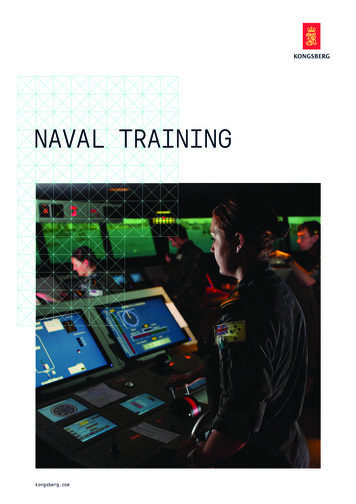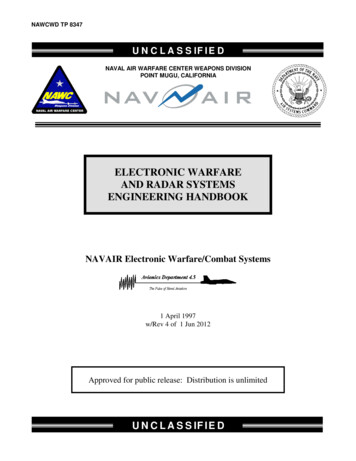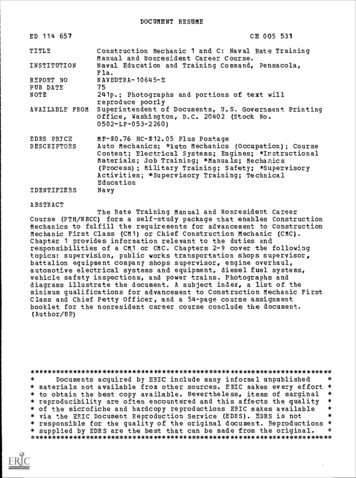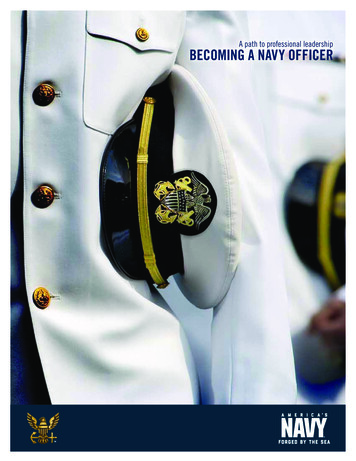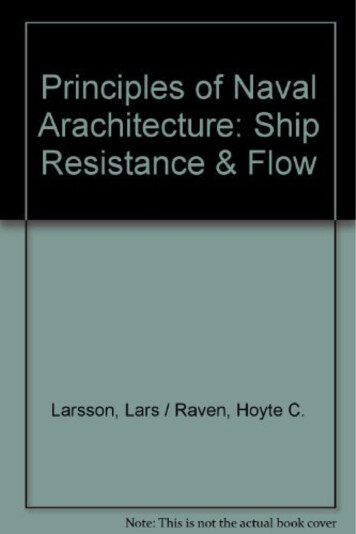
Transcription
The Principles ofNaval Architecture SeriesShip Resistance and FlowLars Larsson and Hoyte C. RavenJ. Randolph Paulling, Editor2010Published byThe Society of Naval Architectsand Marine Engineers601 Pavonia AvenueJersey City, New Jersey 07306
Copyright 2010 by The Society of Naval Architects and Marine Engineers.The opinions or assertions of the authors herein are not to be construed as official orreflecting the views of SNAME, Chalmers University of Technology, MARIN, or any government agency.It is understood and agreed that nothing expressed herein is intended or shall be construedto give any person, firm, or corporation any right, remedy, or claim against the authors ortheir employers, SNAME or any of its officers or member.Library of Congress Cataloging-in-Publication DataLarsson, Lars.Ship resistance and flow / Lars Larsson and Hoyte C. Raven; J. Randolph Paulling, editor.p. cm. — (Principles of naval architecture)Includes bibliographical references and index.ISBN 978-0-939773-76-3 (alk. paper)1. Ship resistance—Mathematics. 2. Inviscid flow—Mathematics. 3. Viscous flow—Mathematics.4. Hulls (Naval architecture)—Mathematics. 5. Ships—Hydrodynamics—Mathematics.I. Raven, Hoyte C. II. Paulling, J. Randolph. III. Title.VM751.L37 2010623.8'12—dc222010020298ISBN 978-0-939773-76-3Printed in the United States of AmericaFirst Printing, 2010
An Introduction to the SeriesThe Society of Naval Architects and Marine Engineers is experiencing remarkable changes in the Maritime Industryas we enter our 115th year of service. Our mission, however, has not changed over the years . . . “an internationallyrecognized . . . technical society . . . serving the maritime industry, dedicated to advancing the art, science andpractice of naval architecture, shipbuilding, ocean engineering, and marine engineering . . . encouraging the exchange and recording of information, sponsoring applied research . . . supporting education and enhancing theprofessional status and integrity of its membership.”In the spirit of being faithful to our mission, we have written and published significant treatises on the subjectof naval architecture, marine engineering, and shipbuilding. Our most well known publication is the “Principlesof Naval Architecture.” First published in 1939, it has been revised and updated three times – in 1967, 1988, andnow in 2008. During this time, remarkable changes in the industry have taken place, especially in technology,and these changes have accelerated. The result has had a dramatic impact on size, speed, capacity, safety, quality, and environmental protection.The professions of naval architecture and marine engineering have realized great technical advances. Theyinclude structural design, hydrodynamics, resistance and propulsion, vibrations, materials, strength analysis usingfi nite element analysis, dynamic loading and fatigue analysis, computer-aided ship design, controllability, stability,and the use of simulation, risk analysis, and virtual reality.However, with this in view, nothing remains more important than a comprehensive knowledge of “fi rst principles.”Using this knowledge, the Naval Architect is able to intelligently utilize the exceptional technology available to itsfullest extent in today’s global maritime industry. It is with this in mind that this entirely new 2008 treatise wasdeveloped – “The Principles of Naval Architecture: The Series.” Recognizing the challenge of remaining relevantand current as technology changes, each major topical area will be published as a separate volume. This will facilitate timely revisions as technology continues to change and provide for more practical use by those who teach,learn or utilize the tools of our profession.It is noteworthy that it took a decade to prepare this monumental work of nine volumes by sixteen authors andby a distinguished steering committee that was brought together from several countries, universities, companies,and laboratories. We are all especially indebted to the editor, Professor J. Randolph (Randy) Paulling for providingthe leadership, knowledge, and organizational ability to manage this seminal work. His dedication to this arduoustask embodies the very essence of our mission . . . “to serve the maritime industry.”It is with this introduction that we recognize and honor all of our colleagues who contributed to this work.Authors:Dr. John S. LetcherDr. Colin S. MooreRobert D. TaggProfessor Alaa Mansour and Dr. Donald LiuProfessor Lars Larsson and Dr. Hoyte C. RavenProfessors Justin E. Kerwin and Jacques B. HadlerProfessor William S. VorusProf. Robert S. Beck, Dr. John Dalzell (Deceased), Prof. Odd Faltinsenand Dr. Arthur M. ReedProfessor W. C. Webster and Dr. Rod BarrHull GeometryIntact StabilitySubdivision and Damaged StabilityStrength of Ships and Ocean StructuresShip Resistance and FlowPropulsionVibration and NoiseMotions in WavesControllabilityControl Committee Members are:Professor Bruce Johnson, Robert G. Keane, Jr., Justin H. McCarthy, David M. Maurer, Dr. William B. Morgan,Professor J. Nicholas Newman and Dr. Owen H. Oakley, Jr.I would also like to recognize the support staff and members who helped bring this project to fruition, especially Susan Evans Grove, Publications Director, Phil Kimball, Executive Director, and Dr. Roger Compton, PastPresident.In the new world’s global maritime industry, we must maintain leadership in our profession if we are to continueto be true to our mission. The “Principles of Naval Architecture: The Series,” is another example of the many waysour Society is meeting that challenge.A DMIRAL ROBERT E. K RAMEKPast President (2007–2008)
NomenclatureAALAMARAReATAtrA( ), B( )a aBbcCBCDCDiCfCFCF0cgCK, CM, CNCPCpCp hdCp hsCRCTCVCX, CY, CZCW DDiEwaveEkinEnEpot EF F Fb, Fp, FvFn, FnLFnBFnhFntrghHHMK, M, Nwave amplitudelateral area of topsides and superstructurearea of midship sectionaspect ratioeffective aspect ratiofrontal (transverse) area of topsides andsuperstructuretransom areawave amplitude functionscoefficient in discretized equationsacceleration vectorship beamwidth of channel or plate, wing spanwave speed, volume fractionblock coefficient of shipdrag coefficientinduced drag coefficientlocal skin friction coefficienttotal skin frictiontotal skin friction for a flat platewave group velocitymoment coefficients about x, y, z-axesprismatic coefficient of ship hull, pressureresistance coefficientpressure coefficienthydrodynamic pressure coefficienthydrostatic pressure coefficientresiduary resistance coefficienttotal resistance coefficientviscous resistance coefficientforce coefficients in x, y, z-directionswave resistance coefficient“circular C”: ship resistance coefficientdrag, diffusion conductanceinduced dragwave energykinetic energy in waveEuler numberpotential energy in wavewave energy fluxvolume flux per unit areaforce vectorbody force, pressure force, and viscousforce, respectivelyFroude number based on ship lengthFroude number based on ship beamFroude number based on water depthFroude number based on tracceleration of gravitywater depthapproximate wave elevation in linearizationmean height of lateral projection of topsides and superstructuremoments about x, y, z-axeskK0,k0kMAAksKLL, LppLpm m mnPDPEPepp*p phdphspmaxp QqRrr1, r2RFRHRijRnRRRTRVRWSs, t, nSijTtU uu, v, wu u u*u V vVA VTW, VAWWwave number, form factor, turbulent kineticenergyfundamental wave numberroughness (Mean Apparent Amplitude)equivalent sand roughness“circular K”: nondimensional speedliftship length (between perpendiculars)length scale of pressure variationmassmass fluxdipole momentwall-normal coordinate, inverse of exponentin velocity profile formuladelivered powereffective powerPeclet numberpressureapproximate pressure in SIMPLE algorithmpressure correction in SIMPLE algorithmhydrodynamic contribution to pressurehydrostatic pressurestagnation pressureundisturbed pressuresource strengthdynamic headdistanceradius of (streamline) curvatureprincipal radii of curvature of a surfacefrictional resistancehydraulic radius of channelReynolds stressReynolds numberresiduary resistancetotal resistanceviscous resistancewave resistancewetted surface, source termcoordinates of local system on free surfacerate of strain tensorship draught, wave period, turbulence leveltime, thrust deduction fractioninflow velocityvelocity vectorflow velocity components in x, y, z-directionsfriction velocitynon-dimensional velocity in wall functionsapproximate velocity in SIMPLE algorithmvelocity correction in SIMPLE algorithmship speedvelocity vectorpropeller advance velocitytrue and apparent wind velocity, respectivelyweight of ship, Coles’ wake function
xxiiWnwX, Y, Zx, y, zy zvztr TW, AW w p 1ij r trDHR 0 0NOMENCLATUREWeber numberwake fractionforces in x, y, z-directionscoordinates of global systemnon-dimensional wall distance in wall functionsdynamic sinkagez-coordinate of transom centroidangle of attackblockage ratio, boundary layer cross-flowangletrue and apparent wind angle, respectivelywall cross-flow anglesurface tension, overspeed ratio in channelvortex strength, generalized diffusion coefficientpressure jump due to surface tensionweight of shipboundary layer thicknessboundary layer displacement thicknessKronecker deltarate of dissipation of turbulent kinetic energywave elevationperturbation of wave elevationwave height deduced from double-bodypressureheight of transom edge above still-watersurfacepropulsive efficiencyhull efficiencyrelative rotative efficiencyopen-water efficiency of propellerwave divergence angle, boundary layer momentum thicknessvon Kàrmàn constantwave lengthlength of transverse wave, fundamental wavelength x eff t eff t ij w ij Indicesa, wM, SPW, E, N, S, T, Bw, e, n, s, t, bx, y, z1, 2, 3length of wave, measured in longitudinal sectiondynamic viscosity, doublet densityeffective dynamic viscosityturbulent dynamic viscositykinematic viscosityeffective kinematic viscosityturbulent kinematic viscositydensitycavitation number, source densitystress tensortrim anglewall shear stressgeneral dependent variable in fi nitevolume theoryvelocity potentialperturbation of potential, in linearizationbase flow potential in linearizationrotation tensorradial frequency, specific rate of dissipation of turbulent energyvorticity vectordisplacementair and water, respectivelymodel and ship, respectivelycentral point in a discretization stencilneighboring points in a discretizationstencilcell facescomponents of a vector in the x-, y-,or z-directionscomponents of a vector in the x-, y-,or z-directions (alternative representation)
PrefaceShip Resistance and FlowDuring the 20 plus years that have elapsed since publication of the previous edition of Principles of Naval Architecture,there have been remarkable advances in the art, science and practice of the design and construction of ships and otherfloating structures. In that edition, the increasing use of high speed computers was recognized and computationalmethods were incorporated or acknowledged in the individual chapters rather than being presented in a separatechapter. Today, the electronic computer is one of the most important tools in any engineering environment and thelaptop computer has taken the place of the ubiquitous slide rule of an earlier generation of engineers.Advanced concepts and methods that were only being developed or introduced then are a part of commonengineering practice today. These include fi nite element analysis, computational fluid dynamics, random processmethods, numerical modeling of the hull form and components, with some or all of these merged into integrateddesign and manufacturing systems. Collectively, these give the naval architect unprecedented power and flexibilityto explore innovation in concept and design of marine systems. In order to fully utilize these tools, the modernnaval architect must possess a sound knowledge of mathematics and the other fundamental sciences that form abasic part of a modern engineering education.In 1997, planning for the new edition of Principles of Naval Architecture was initiated by the SNAME publications manager who convened a meeting of a number of interested individuals including the editors of PNA and thenew edition of Ship Design and Construction on which work had already begun. At this meeting it was agreedthat PNA would present the basis for the modern practice of naval architecture and the focus would be principlesin preference to applications. The book should contain appropriate reference material but it was not a handbookwith extensive numerical tables and graphs. Neither was it to be an elementary or advanced textbook although itwas expected to be used as regular reading material in advanced undergraduate and elementary graduate courses.It would contain the background and principles necessary to understand and to use intelligently the modern analytical, numerical, experimental, and computational tools available to the naval architect and also the fundamentals needed for the development of new tools. In essence, it would contain the material necessary to develop theunderstanding, insight, intuition, experience, and judgment needed for the successful practice of the profession.Following this initial meeting, a PNA Control Committee, consisting of individuals having the expertise deemednecessary to oversee and guide the writing of the new edition of PNA, was appointed. This committee, after participating in the selection of authors for the various chapters, has continued to contribute by critically reviewingthe various component parts as they are written.In an effort of this magnitude, involving contributions from numerous widely separated authors, progress hasnot been uniform and it became obvious before the halfway mark that some chapters would be completed beforeothers. In order to make the material available to the profession in a timely manner it was decided to publish eachmajor subdivision as a separate volume in the Principles of Naval Architecture Series rather than treating each asa separate chapter of a single book.Although the United States committed in 1975 to adopt SI units as the primary system of measurement the transition is not yet complete. In shipbuilding as well as other fields we still fi nd usage of three systems of units: Englishor foot-pound-seconds, SI or meter-newton-seconds, and the meter-kilogram(force)-second system common inengineering work on the European continent and most of the non-English speaking world prior to the adoption ofthe SI system. In the present work, we have tried to adhere to SI units as the primary system but other units maybe found, particularly in illustrations taken from other, older publications. The symbols and notation follow, ingeneral, the standards developed by the International Towing Tank Conference.A major goal in the design of virtually all vessels as varied as commercial cargo and passenger ships, navalvessels, fishing boats, and racing yachts, is to obtain a hull form having favorable resistance and speed characteristics. In order to achieve this goal the prediction of resistance for a given hull geometry is of critical importance.Since the time of publication of the previous edition of PNA important advances have been made in theoretical andcomputational fluid dynamics and there has been a steady increase in the use of the results of such work in shipand offshore structure design. The present volume contains a completely new presentation of the subject of shipresistance embodying these developments. The first section of the book provides basic understanding of the flowphenomena that give rise to the resistance encountered by a ship moving in water. The second section containsan introduction to the methods in common use today by which that knowledge is applied to the prediction of theresistance. A third and fi nal section provides guidance to the naval architect to aid in designing a hull form havingfavorable resistance characteristics.
xviPREFACEWilliam Froude in the 1870s proposed the separation of total resistance into frictional and residual parts, theformer equal to that of a flat plate of the same length, speed, area, and roughness as the ship wetted surface, andthe latter principally due to ship generated waves. Since Froude’s time, much research has been conducted toobtain better formulations of the flat plate resistance with refi nements to account for the three dimensional natureof the flow over the curved shape of the hull. Simultaneously, other research effort has been directed to obtaining abetter understanding of the basic nature of the flow of water about the ship hull and how this flow affects the totalresistance.The three methods currently in general use for determining ship resistance are model tests, empirical methods, and theory. In model testing, refi nements in Froude’s method of extrapolation from model to full scale aredescribed. Other experimental topics include wave profile measurements, wake surveys, and boundary layer measurements. Empirical methods are described that make use of data from previous ships or model experiments.Results for several “standard series” representing merchant ships, naval vessels, fi shing vessels, and yachts arementioned and statistical analyses of accumulated data are reviewed.The theoretical formulation of ship resistance began with the linear thin ship theory of Michell in 1898. The present volume develops the equations of inviscid and viscous flow in two and three dimensions, including free surfaceeffects and boundary conditions. From this basis are derived numerical and computational methods for characterizing the flow about a ship hull. Modern computing power allows these methods to be implemented in practicalcodes and procedures suitable for engineering application. Today, it is probable that many, if not most, large shipsare designed using computational fluid dynamics, or CFD, in some form either for the design of the entire hull orfor components of the hull and appendages.Concluding sections describe design considerations and procedures for achieving favorable flow and resistancecharacteristics of the hull and appendages. Examples are covered for ships designed for high, medium, and lowspeed ranges. Design considerations affecting both wave and viscous effects are included. A fi nal section discussesflow in the stern wake that has important implications for both resistance and propeller performance.J. RANDOLPH PAULLINGEditor
Table of ContentsAn Introduction to the Series . . . . . . . . . . . . . . . . . . . . . . . . . . . . . . . . . . . . . . . . . . . . . . . . . . . . . . . . . . . . . . . . . . . . . .xiForeword . . . . . . . . . . . . . . . . . . . . . . . . . . . . . . . . . . . . . . . . . . . . . . . . . . . . . . . . . . . . . . . . . . . . . . . . . . . . . . . . . . . . . . .xiiiPreface . . . . . . . . . . . . . . . . . . . . . . . . . . . . . . . . . . . . . . . . . . . . . . . . . . . . . . . . . . . . . . . . . . . . . . . . . . . . . . . . . . . . . . . . .xvAcknowledgments . . . . . . . . . . . . . . . . . . . . . . . . . . . . . . . . . . . . . . . . . . . . . . . . . . . . . . . . . . . . . . . . . . . . . . . . . . . . . . .xviiAuthors’ Biography. . . . . . . . . . . . . . . . . . . . . . . . . . . . . . . . . . . . . . . . . . . . . . . . . . . . . . . . . . . . . . . . . . . . . . . . . . . . . . .xixNomenclature . . . . . . . . . . . . . . . . . . . . . . . . . . . . . . . . . . . . . . . . . . . . . . . . . . . . . . . . . . . . . . . . . . . . . . . . . . . . . . . . . . .xxi1Introduction. . . . . . . . . . . . . . . . . . . . . . . . . . . . . . . . . . . . . . . . . . . . . . . . . . . . . . . . . . . . . . . . . . . . . . . . . . . . . . . . . . . . . 11.1 The Importance of Accurate Resistance Predictions . . . . . . . . . . . . . . . . . . . . . . . . . . . . . . . . . . . . . . . . . . . . . . 11.2 Different Ways to Predict Resistance . . . . . . . . . . . . . . . . . . . . . . . . . . . . . . . . . . . . . . . . . . . . . . . . . . . . . . . . . . . 11.2.1Model Testing . . . . . . . . . . . . . . . . . . . . . . . . . . . . . . . . . . . . . . . . . . . . . . . . . . . . . . . . . . . . . . . . . . . . . . . . . 11.2.2Empirical Methods. . . . . . . . . . . . . . . . . . . . . . . . . . . . . . . . . . . . . . . . . . . . . . . . . . . . . . . . . . . . . . . . . . . . . 21.2.3Computational Techniques . . . . . . . . . . . . . . . . . . . . . . . . . . . . . . . . . . . . . . . . . . . . . . . . . . . . . . . . . . . . . . 31.2.4Use of the Methods . . . . . . . . . . . . . . . . . . . . . . . . . . . . . . . . . . . . . . . . . . . . . . . . . . . . . . . . . . . . . . . . . . . . 41.3 The Structure of this Book . . . . . . . . . . . . . . . . . . . . . . . . . . . . . . . . . . . . . . . . . . . . . . . . . . . . . . . . . . . . . . . . . . . . 52Governing Equations . . . . . . . . . . . . . . . . . . . . . . . . . . . . . . . . . . . . . . . . . . . . . . . . . . . . . . . . . . . . . . . . . . . . . . . . . . . . . 52.1 Global Coordinate System . . . . . . . . . . . . . . . . . . . . . . . . . . . . . . . . . . . . . . . . . . . . . . . . . . . . . . . . . . . . . . . . . . . . 52.2 The Continuity Equation . . . . . . . . . . . . . . . . . . . . . . . . . . . . . . . . . . . . . . . . . . . . . . . . . . . . . . . . . . . . . . . . . . . . . . 52.3 The Navier-Stokes Equations . . . . . . . . . . . . . . . . . . . . . . . . . . . . . . . . . . . . . . . . . . . . . . . . . . . . . . . . . . . . . . . . . . 62.4 Boundary Conditions. . . . . . . . . . . . . . . . . . . . . . . . . . . . . . . . . . . . . . . . . . . . . . . . . . . . . . . . . . . . . . . . . . . . . . . . . 82.4.1Solid Surfaces . . . . . . . . . . . . . . . . . . . . . . . . . . . . . . . . . . . . . . . . . . . . . . . . . . . . . . . . . . . . . . . . . . . . . . . . . 82.4.2Water Surface . . . . . . . . . . . . . . . . . . . . . . . . . . . . . . . . . . . . . . . . . . . . . . . . . . . . . . . . . . . . . . . . . . . . . . . . . 92.4.3Infinity . . . . . . . . . . . . . . . . . . . . . . . . . . . . . . . . . . . . . . . . . . . . . . . . . . . . . . . . . . . . . . . . . . . . . . . . . . . . . . . 92.5 Hydrodynamic and Hydrostatic Pressure . . . . . . . . . . . . . . . . . . . . . . . . . . . . . . . . . . . . . . . . . . . . . . . . . . . . . . . . 93Similarity. . . . . . . . . . . . . . . . . . . . . . . . . . . . . . . . . . . . . . . . . . . . . . . . . . . . . . . . . . . . . . . . . . . . . . . . . . . . . . . . . . . . 103.1 Types of Similarity . . . . . . . . . . . . . . . . . . . . . . . . . . . . . . . . . . . . . . . . . . . . . . . . . . . . . . . . . . . . . . . . . . . . . . . . . . 103.2 Proof of Similarity . . . . . . . . . . . . . . . . . . . . . . . . . . . . . . . . . . . . . . . . . . . . . . . . . . . . . . . . . . . . . . . . . . . . . . . . . . 103.3 Consequences of the Similarity Requirements . . . . . . . . . . . . . . . . . . . . . . . . . . . . . . . . . . . . . . . . . . . . . . . . . . 113.3.1Summary of Requirements . . . . . . . . . . . . . . . . . . . . . . . . . . . . . . . . . . . . . . . . . . . . . . . . . . . . . . . . . . . . . 113.3.2The Dilemma in Model Testing . . . . . . . . . . . . . . . . . . . . . . . . . . . . . . . . . . . . . . . . . . . . . . . . . . . . . . . . . 12
iv4SHIP RESISTANCE AND FLOWDecomposition of Resistance . . . . . . . . . . . . . . . . . . . . . . . . . . . . . . . . . . . . . . . . . . . . . . . . . . . . . . . . . . . . . . . . . . . . . 134.1 Resistance on a Straight Course in Calm, Unrestricted Water. . . . . . . . . . . . . . . . . . . . . . . . . . . . . . . . . . . . . . 134.1.1Vessel Types . . . . . . . . . . . . . . . . . . . . . . . . . . . . . . . . . . . . . . . . . . . . . . . . . . . . . . . . . . . . . . . . . . . . . . . . . 134.1.2Detailed Decomposition of the Resistance . . . . . . . . . . . . . . . . . . . . . . . . . . . . . . . . . . . . . . . . . . . . . . . 134.1.3Comparison of the Four Vessel Types . . . . . . . . . . . . . . . . . . . . . . . . . . . . . . . . . . . . . . . . . . . . . . . . . . . . 154.2 Other Resistance Components. . . . . . . . . . . . . . . . . . . . . . . . . . . . . . . . . . . . . . . . . . . . . . . . . . . . . . . . . . . . . . . . 155Inviscid Flow Around the Hull, Wave Making, and Wave Resistance . . . . . . . . . . . . . . . . . . . . . . . . . . . . . . . . . . . . 165.1 Introduction . . . . . . . . . . . . . . . . . . . . . . . . . . . . . . . . . . . . . . . . . . . . . . . . . . . . . . . . . . . . . . . . . . . . . . . . . . . . . . . 165.2 Inviscid Flow Around a Body . . . . . . . . . . . . . . . . . . . . . . . . . . . . . . . . . . . . . . . . . . . . . . . . . . . . . . . . . . . . . . . . . 165.2.1Governing Equations . . . . . . . . . . . . . . . . . . . . . . . . . . . . . . . . . . . . . . . . . . . . . . . . . . . . . . . . . . . . . . . . . . 165.2.2Inviscid Flow Around a Two-Dimensional Body . . . . . . . . . . . . . . . . . . . . . . . . . . . . . . . . . . . . . . . . . . . 185.2.3Inviscid Flow Around a Three-Dimensional Body . . . . . . . . . . . . . . . . . . . . . . . . . . . . . . . . . . . . . . . . . 195.3 Free-Surface Waves . . . . . . . . . . . . . . . . . . . . . . . . . . . . . . . . . . . . . . . . . . . . . . . . . . . . . . . . . . . . . . . . . . . . . . . . . 205.3.1Derivation of Sinusoidal Waves . . . . . . . . . . . . . . . . . . . . . . . . . . . . . . . . . . . . . . . . . . . . . . . . . . . . . . . . . 225.3.2Properties of Sinusoidal Waves . . . . . . . . . . . . . . . . . . . . . . . . . . . . . . . . . . . . . . . . . . . . . . . . . . . . . . . . . 235.4 Ship Waves . . . . . . . . . . . . . . . . . . . . . . . . . . . . . . . . . . . . . . . . . . . . . . . . . . . . . . . . . . . . . . . . . . . . . . . . . . . . . . . . 245.4.1Two-Dimensional Waves . . . . . . . . . . . . . . . . . . . . . . . . . . . . . . . . . . . . . . . . . . . . . . . . . . . . . . . . . . . . . . . 245.4.2Three-Dimensional Waves . . . . . . . . . . . . . . . . . . . . . . . . . . . . . . . . . . . . . . . . . . . . . . . . . . . . . . . . . . . . . 255.4.3The Kelvin Pattern . . . . . . . . . . . . . . . . . . . . . . . . . . . . . . . . . . . . . . . . . . . . . . . . . . . . . . . . . . . . . . . . . . . . 265.4.4Ship Wave Patterns . . . . . . . . . . . . . . . . . . . . . . . . . . . . . . . . . . . . . . . . . . . . . . . . . . . . . . . . . . . . . . . . . . . 275.4.5Interference Effects . . . . . . . . . . . . . . . . . . . . . . . . . . . . . . . . . . . . . . . . . . . . . . . . . . . . . . . . . . . . . . . . . . . 295.4.6The Ship Wave Spectrum . . . . . . . . . . . . . . . . . . . . . . . . . . . . . . . . . . . . . . . . . . . . . . . . . . . . . . . . . . . . . . 305.5 Wave Resistance. . . . . . . . . . . . . . . . . . . . . . . . . . . . . . . . . . . . . . . . . . . . . . . . . . . . . . . . . . . . . . . . . . . . . . . . . . . . 315.6 Wave Breaking and Spray . . . . . . . . . . . . . . . . . . . . . . . . . . . . . . . . . . . . . . . . . . . . . . . . . . . . . . . . . . . . . . . . . . . . 345.7 Viscous Effects on Ship Wave Patterns. . . . . . . . . . . . . . . . . . . . . . . . . . . . . . . . . . . . . . . . . . . . . . . . . . . . . . . . . 355.8 Shallow-Water Effects on Wave Properties . . . . . . . . . . . . . . . . . . . . . . . . . . . . . . . . . . . . . . . . . . . . . . . . . . . . . 365.9 Shallow-Water Effects on Ship Wave Patterns . . . . . . . . . . . . . . . . . . . . . . . . . . . . . . . . . . . . . . . . . . . . . . . . . . . 385.9.1Low Subcritical: Fnh 0.7 . . . . . . . . . . . . . . . . . . . . . . . . . . . . . . . . . . . . . . . . . . . . . . . . . . . . . . . . . . . . . 385.9.2High Subcritical: 0.7 Fnh 0.9 . . . . . . . . . . . . . . . . . . . . . . . . . . . . . . . . . . . . . . . . . . . . . . . . . . . . . . . . 395.9.3(Trans)critical: 0.9 Fnh 1.1 . . . . . . . . . . . . . . . . . . . . . . . . . . . . . . . . . . . . . . . . . . . . . . . . . . . . . . . . . 405.9.4Supercritical: Fnh 1 . . . . . . . . . . . . . . . . . . . . . . . . . . . . . . . . . . . . . . . . . . . . . . . . . . . . . . . . . . . . . . . . . 415.10 Shallow-Water Effects on Resistance . . . . . . . . . . . . . . . . . . . . . . . . . . . . . . . . . . . . . . . . . . . . . . . . . . . . . . . . . . 42
SHIP RESISTANCE AND FLOWv5.11 Far-Field Waves and Wash . . . . . . . . . . . . . . . . . . . . . . . . . . . . . . . . . . . . . . . . . . . . . . . . . . . . . . . . . . . . . . . . . . . 465.11.1 Introduction . . . . . . . . . . . . . . . . . . . . . . . . . . . . . . . . . . . . . . . . . . . . . . . . . . . . . . . . . . . . . . . . . . . . . . . . . 465.11.2 Far-Field Wave Amplitudes. . . . . . . . . . . . . . . . . . . . . . . . . . . . . . . . . . . . . . . . . . . . . . . . . . . . . . . . . . . . . 475.11.3 Far-Field Wave Periods . . . . . . . . . . . . . . . . . . . . . . . . . . . . . . . . . . . . . . . . . . . . . . . . . . . . . . . . . . . . . . . . 485.12 Channel Effects . . . . . . . . . . . . . . . . . . . . . . . . . . . . . . . . . . . . . . . . . . . . . . . . . . . . . . . . . . . . . . . . . . . . . . . . . . . . 486The Flow Around the Hull and the Viscous Resistance. . . . . . . . . . . . . . . . . . . . . . . . . . . . . . . . . . . . . . . . . . . . . . . . 516.1 Body-Fitted Coordinate System . . . . . . . . . . . . . . . . . . . . . . . . . . . . . . . . . . . . . . . . . . . . . . . . . . . . . . . . . . . . . . . 516.2 The Boundary Layer . . . . . . . . . . . . . . . . . . . . . . . . . . . . . . . . . . . . . . . . . . . . . . . . . . . . . . . . . . . . . . . . . . . . . . . . 516.2.1Physical Description of the Boundary Layer . . . . . . . . . . . . . . . . . . . . . . . . . . . . . . . . . . . . . . . . . . . . . . 516.2.2Approximations of First Order Boundary Layer Theory . . . . . . . . . . . . . . . . . . . . . . . . . .
of naval architecture, marine engineering, and shipbuilding. Our most well known publication is the “Principles of Naval Architecture.” First published in 1939, it has been revised and updated three times – in 1967, 1988, and now in 2008. During this time, remarkable changes in

